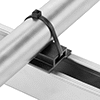Filter by
Mount Type
Cable Tie Style
Material
Mounting Hole Diameter
Width
UV Protection
Performance
Overall Length
Maximum Temperature
For Maximum Cable Tie Thickness
Overall Height
DFARS Specialty Metals
Material Handling
Building and Machinery Hardware
































